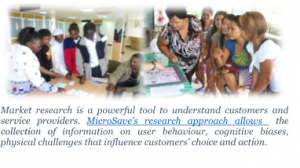Embracing A Market-led Approach To Developing Product Concepts
 by Graham Wright, Akhand Tiwari and Bhavana Srivastava
by Graham Wright, Akhand Tiwari and Bhavana Srivastava Nov 5, 2015
Nov 5, 2015 6 min
6 min
In this blog post, we reveal the secrets of how the mantra of a “market-led approach” actually works for product development in financial services
According to the World Bank’s Global Financial Inclusion Database, more than 2.5 billion adults do not have an account at a financial institution. Among the many factors that are responsible for this high level of financial exclusion, poor design of financial products is key.
Why, then, is it so difficult to design financial services for the poor?
Unlike populations who receive predictable incomes into their bank accounts, poor people’s financial flows are far more complicated. There are multiple contextual elements – scarcity of income, lack of buffers (emergency funds), inadequacy of information, inaccessibility to financial services, and uncertain cash flows. Equally difficult to understand is the poor’s choice of financial services such as apparently extortionate Bombay 5-6s or in-kind savings, or village level ROSCAs. Then how does one approach financial product development for the poor?
MicroSave’s guidestar – market-led solutions for financial services – has helped us develop product concepts that are now used by millions of poor people across the globe. In this blog post, we reveal the secrets of how this mantra of a “market-led approach” actually works.
Secret 1: Significance of understanding the “market”

A key differentiator of our approach is the premise that the market involves both financial service providers and their customers. A product will succeed only when a provider’s strategic vision and institutional capacity are aligned with the product ideas emerging from market research. Although this may sound obvious and basic, this fact differentiates success from failure. A provider may conceive a fantastic, ‘out of the box’ product idea, but whether it will be developed and/or implemented successfully depends on the provider’s intent and capabilities as well as business environment. CGAPs’ Insight into Action, which documents their experiences in using Human Centred Design to develop product concepts, reports that many product ideas could not actually be implemented either because of lack of buy-in from departments of providers – Bancomer in Mexico, or for other pressing needs of provider – MTN Uganda. The No-Frills-Accounts offered by multiple banks in India are a similar story. The Government focussed on addressing only one challenge faced by the financially excluded population – an extremely complicated account opening process. They overlooked many aspirations of these people from a bank account, that is – quicker services at branches, access to information on banking services, respect associated with a bank account, etc. The product design also ignored the capacities of the banks and the aspect of motivation of the staff who were to offer this product.
Of course, the starting point for a product concept is the basic understanding of existing behaviour. While talking to customers of a leading bank in Kenya on a savings product concept, a key insight was that a ‘lock-in feature for a fixed period’ was actually desirable and could encourage their discipline to save.
Understanding market insights does not always lead to ‘successful’ product design unless service providers strategically align themselves to the product concept and are thus ready, willing and capable to deliver the product. In Nepal, many practitioners embraced digital financial products and created agent networks. Agents began to offer banking products but there were not many adopters. The providers had assumed that customers wanted to use formal financial services and that agents would solve the problem of inaccessibility to these services. This was a correct supposition, but there was more to it. People did indeed want access to formal financial services, but not at the cost of convenience. Opening an account required at least four visits to agent outlets – as a result, very few people transitioned from village level cooperatives and most agents remained unused. In this case, the service providers did not have the capabilities to develop and support a network of agents robust enough to service targeted customers. (See also Lessons from emerging markets, Why robust agent network is crucial, How agent networks fuel M-PESA’s success).
While developing product concepts with a dozen banks in east and southern Africa (2001-2006), MicroSave documented the importance of strategic planning and the need to ensure buy-in from all departments. Strategic planning helps to manage the growth process and build systems so that a product concept does not face any unnecessary challenges. For example when Teba Bank upgraded their banking system, they found that customisation took longer than anticipated. Worse still, as banking systems fill to capacity, they slow down – each transaction takes longer. Ensuring buy-in from all departments helps to avoid problems with legal, regulatory, audit and IT systems; as well as to reduce the risk of “product orphans” by ensuring that the departments that must roll the product out are involved from the beginning. (More lessons from MicroSave’s Action Research Programme – 2002, 2003, and 2006).
Secret 2: Participatory creation and refinement of concepts through testing
Understanding the market gives researchers multiple ideas for product concepts. While some of these ideas evolve in the field, some are discovered in participative concept distillation workshops.
In the example from Kenya above, we knew that we needed to build in a contextual factor that would curb the temptation to spend. We took the market insight to the concept distillation workshop. We encouraged bank staff to think about how the bank could induce self-disciplinary saving behaviour amongst its clients. In the light of this understanding of the market, various ideas generated in the workshop suggested a savings product that committed the customer to a goal, a specific amount of regular savings to achieve it, and a lock-in period to avoid premature encashment. However, this was just the starting point. We needed to understand what clients actually thought about it.
In a market-led product development process, understanding customer need is not a one-off activity. It is a continuous process where product concepts are developed, tested and modified through a series of iterations. The objective and scale of each iteration may vary. While the first phase essentially focuses on understanding the behaviour of existing and prospective customers, in the later phases we evaluate whether the product concept will be able to bring about the behaviour change that the service provider expects from the new/modified product. This process helps optimise the product’s value proposition for users. The result of this exercise is a product concept that works – M-PESA provides an excellent example of this. The initial idea (developed without market research) was wrong – for both the clients as well as the microfinance institution. However, the process of concept-testing made way for the re-invention of the product – right down to the processes and marketing/communication around it. Testing continues throughout the journey of product development. It starts at a conceptual level and continues until the development of systems and processes.
In Kenya, we tested the idea of commitment savings at various levels (customers and staff) and stages of development – from on-paper concept to soft launch. During all the testing, we focussed on assessing clients’ attitudes, perceptions and behaviour towards the adoption of these products, identifying the key risks involved, and testing the processes, technology and operational activities. The result of this exercise led to the development of a successful savings product that we now know as Jijenge product offered by Equity Bank.
Secret 3: Focus on 8Ps
Product design, pricing, people, process, place, physical evidence, promotion, positioning – collectively the “8Ps of marketing” is all about focusing on the details and can be used in various contexts – 8Ps for DFS, 8Ps for savings, 8Ps for marketing. At any stage of product concept development, attention to the 8Ps keeps product design experts focused on all of the elements they need to elucidate and develop. If these details are not well thought through, recorded, and shared with the team, there are high chances that many crucial aspects might be missed or overlooked while a product is tested. In our journey to develop the refined version of Jijenge in 2012, formulation of 8Ps indicated that the product would also be launched on the digital Eazy 247 platform. The product development team knew this and subsequently modified the Eazy247 platform to incorporate Jijenge. The market research also provided insights into the optimal channel and messaging for the promotion of the product. Adoption of the 8Ps-based approach ensures that product development team members will also initiate activities to market/communicate the product. The 8Ps framework implies that all aspects of the product are examined in an integrated manner and everybody in the team is on the same page.
MicroSave has developed more than 200 products for a wide range of banking, digital financial service provider, MSME, microfinance and third party aggregator clients for nearly 20 years. We can confidently say that there are no magic formulae for designing financial products for poor people. Success lies in following a careful and systematic product development process. This process starts with market insights through rigorous market research (remember market = customers and providers); a participative approach to concept development and iterative testing of the concepts to final rollout; and attention to all the 8Ps.
Written by

Graham Wright
Group Managing Director
Akhand Tiwari
Senior Partner
Leave comments